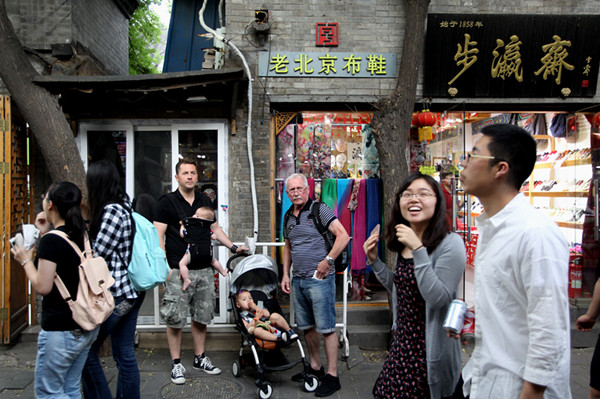 |
|
Despite the recent ban on tour groups in Nanluoguxiang, many individual tourists from home and abroad visit there for its fame.[Photo by Zhang Wei/ China Daily] |
Fame and fortune prove to be a toxic mix for a tourist attraction.
When the pronouncement was made it was akin to a doctor telling a patient he must give up drinking and smoking-and that if he is to survive one of his legs will have to be amputated.
The patient in question is Nanluoguxiang, an area of Beijing that has grown fat on the attention and money of tourists over the past 10 years and now lies enfeebled, its arteries clogged.
Those arteries are the area's main alley, about 800 meters long, and the 16 alleys that run off it to either side which once bustled with healthy activity and were the toast of the tourist industry.
In the heady days, which began about the time of the Beijing Olympics in 2008, tourists, most of them overseas ones, flocked to Nanluoguxiang, which has a history dating back 700 years, to roam through the alleys with their old courtyard houses, cafes, bars and creative shops.
The pronouncement in question came six weeks ago, when Dongcheng district said that Nanluoguxiang had voluntarily renounced its title of national AAA-level scenic spot-an implicit admission that tourism has brought ills as well as benefits to the area.
If that were not enough, it was announced that tour buses, often the life blood of tourism operations, would forthwith be banned, helping reduce road traffic and improve the lot of residents and historic buildings alike.
Nanluoguxiang is emblematic of many tourist sites around China whose promoters walk a fine line between raising awareness of local culture by showing it off to tourists but in doing so risk doing irreparable damage to that culture by dint of the huge numbers that flood in, changing the very nature of the place.
In the case of Nanluoguxiang, the place became so well known that Chinese joined their overseas counterparts in flooding in to enjoy it, leaving it overcrowded, and those numbers fed rampant commercialization whose agents became crass purveyors of goods that you can find in myriad other tourist spots throughout China.
On April 30, five days after Dongcheng announced that it was taking action to try to remedy Nanluoguxiang's ills, 70,000 tourists visited the area, about 23,000 fewer than had been there on the previous April 30, offering long dreamed of respite for harried local residents, who now do not have to worry as much about nosey tourists invading their privacy wanting to know what courtyard houses look like.
However, for businesspeople the changes have acted as a warning that they need to act decisively if the neighborhood is to thrive again.
"We would like Nanluoguxiang to be an interesting place that attracts lively people," says Xu Yan, president of the local Chamber of Commerce. "It's critical that we do something about the downmarket business operators such as snack dealers and make it a place full of innovation again."
Tourist groups now mainly stay for only about 40 minutes and consume little and though the new policies have done a lot to ease traffic congestion they have had little impact on business, he says.
On May 17 the district government announced a three-year plan to better develop the rich historic resources of Nanluoguxiang and set a target for more than 60 percent of establishments to have a cultural theme by the end of 2018.
The chamber is doing its bit with the government to give the area a new face and character by persuading businesses to smarten up their act. More than 80 stores will be shut down temporarily or permanently in early June, because of licensing irregularities, the way they were running their businesses and the physical appearance of their shops that was deemed to be unfit for the historic area.
When Xu opened his restaurant called Taste in 2007 there were just 56 stores in the main thoroughfare and at one point this grew to as many as about 250.
In 2009, the year after the Olympics, the area had attained worldwide acclaim, Time magazine ranking it among its 25 places for the best authentic Asian experience.
|
|
|
|
|
|
|
|
